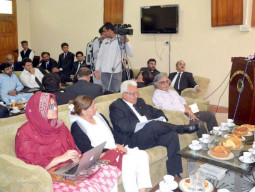
The rationale of a nation state is to end disparities by careful planning and allocation of national and provincial resources. Not that every region of the country and regions within provinces have the same matrix of development and similar disparities that existed during colonial rule, but the fact is that we haven’t really succeeded in bringing all parts of the country at a somewhat similar level. Maybe that is too ambitious an objective; the minimum we might target is addressing poverty and economic inequality.
In restructuring the federation under the Eighteenth Amendment, we have taken the first right step — transfer of power, responsibility and resources to the provinces. Each province is a new centre of power. If power and resources are not devolved further to the regions and districts, the new centres are likely to ignite ethnic identities that have historical roots and that may also transform into demands for new provinces. Punjab is more vulnerable to division than the other provinces. The Seraiki linguistic identity and the history of the two states of Multan and Bahawalpur run deep into the political mind of ordinary people in southern Punjab. In recent decades, the ethnic groups within these regions have developed a political narrative of neglect and discrimination that is supported by facts relating to uneven development among the various geographic regions of Punjab. There is still time to do some path correction in southern Punjab to avert the politicisation of linguistic and ethnic identities. The PML-N cannot take its victory as a defeat of the Seraiki sentiment — that will be a big mistake. Rather, this victory provides yet another opportunity to look into the growing Seraiki alienation from Punjab.
It is true that in recent years, the development allocations for the southern regions represent population size of the districts, but then, there are other factors like landlessness, poverty, a low literacy rate and an oppressive feudal system that require a more thoughtful intervention to create social and economic space for the marginalised.
Even the bigger allocation of resources for development may end up in private pockets without proper accountability and transparency. The problem is that political and social power is in the hands of tribal and feudal families, supported by the federation and the provincial power structure. The levers of justice, governance, law and order and equity in development have thus left a strong imprint of partisan politics that only works in the interest of patronage politics.
For these reasons, southern Punjab is witnessing a climate of controlled anarchy in vital public and social spheres. For years, we have seen kidnapping gangs, breakdown of the legal regime of canal water distribution, ghost schools, corruption in infrastructure projects and religious extremism on the rise — the effects of long years of neglect.
Published in The Express Tribune, July 16th, 2013.
Like Opinion & Editorial on Facebook, follow @ETOpEd on Twitter to receive all updates on all our daily pieces.
COMMENTS (5)
Comments are moderated and generally will be posted if they are on-topic and not abusive.
For more information, please see our Comments FAQ


























1714024018-0/ModiLara-(1)1714024018-0-270x192.webp)










@Engr.S.T.Hussain: I hope that the Sharifs have the political wisdom to not divide Punjab which is the only stable and developing province in Pakistan. I hope Sharifs have the wisdom not to create more unstable provinces with an additional bloated provincial bureaucracy. If Punjab continues its current march to development and progress, all parts of the Punjab periphery will progress along with Central and Northern Punjab. On the other hand the Seraika Belt of Punjab is the only place where one sees feudalism such as in interior Sind and Baluchistan. I can guarantee you that the Seraiki speaking part of Punjab will not develop if the feudal Serakis are given a separate province to mismanage. If we really care about developing Seraiki speaking people in Punjab, the best bet for an educated, prosperous middle class to evolve is to stay with the rest of Punjab which is being touted as one of the fastest growing middle classes in the world.
I do not think that Nawaz Sharif PM and Shabaz Sharif CM Punjab have Political wisdom to take themself steps to divide Punjab into new Provinces and devolve power to grass rootl level.I doubt if they are going to allow local government election.They donot trust any member of their party is more wiser and capable.They donot believe in collective wisdom.It is Sharif Brother last chance to rule Pakistan.
@Rasul Bukhsh Ji, The gist of your article well taken, the argument about rationale of nation is little off the wall. Please have a look at the history of state formation in Europe and theories that evolved from that experience (all the way from Charles Tilly down to contemporary theorists). To make my point the modern nation state was a product of labor pains of thirty years war and resultant delivery in the form of Treaty of Westphalia (1648). The state actually became omnipotent, and centralized coercion became a norm than aberration. The developments that you are talking are recent occurrences in European states. Transformation from merchant capitalist to industrial capitalism is what is generally associated to democratization, decentralization of power(your argument), and rule of law. Please have a look at the following article by Tony Marx,The Nation-State and Its Exclusions, Political Science Quarterly Vol 117, # 1, (Spring 2002).
The issues that you brought up are actually national and not confined to southern Punjab. It is state's inability to penetrate, coerce, and extract. The state in Pakistan is still in the hands of traditional classes and not an autonomous political entity. Thus the possibility of flexing its muscle does not exist. Regards.
"The PML-N cannot take its victory as a defeat of the Seraiki sentiment — that will be a big mistake. Rather, this victory provides yet another opportunity to look into the growing Seraiki alienation from Punjab." Very well said. While all the top positions from PM, CM and others are from one city Lahore how would the people of S. Punjab feel? It is about time we spend more money on the uplift of backward areas and provinces to bring them at par.
Thank you. A very concise and right on the money analysis. I hope some one amongst those who claim to have earned the mandates can listen and UNDERSTAND what is being said here. Unfortunately if Abbottabad Commission report is to be believed our political leadership does not have the capacity to read, understand and analyze the complex issues that Pakistan faces on top of the fact that they do not really care.